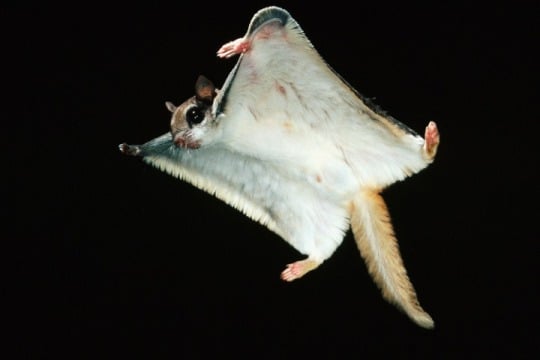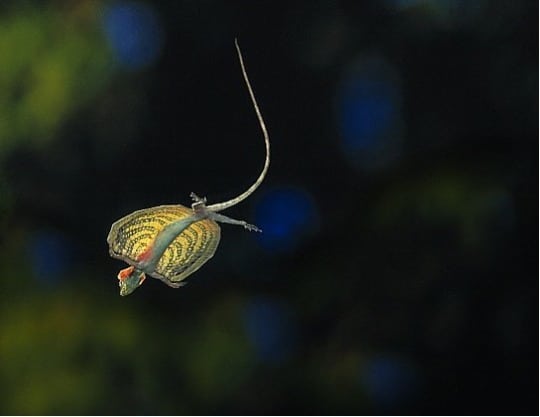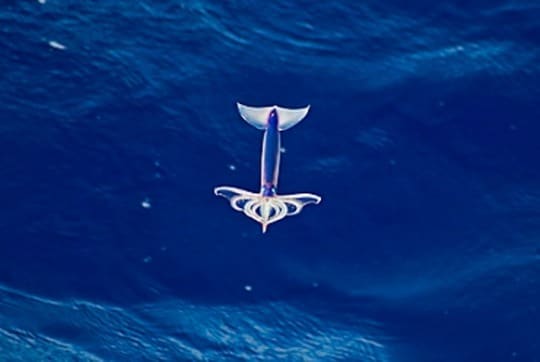Look up in the sky—it’s a bird! No, a plane! It’s…it’s…a squid?! Most people wouldn’t expect a squid to fly, but truth is sometimes stranger than comic book fiction. The natural world is full of wonderful surprises, including many creatures that seemingly have no business being airborne. They can live in very different habitats, ranging from beneath the ocean waves to high up in the tree tops of a rainforest. Yet all these animals have expertly managed to adapt to their environments and utilize flight as a successful survival tool.
Flying Mammals
Wouldn’t it be a strange world if mice and rats could fly? Besides being a housecat’s worst nightmare, this notion also seems unbelievable. But out in the amazing world of wildlife, this isn’t so far from the truth! Gliding mammals can be found around the globe, from the tiniest of these arboreal aerialists, the Mighty-Mouse-sized Feathertail Glider, which lives in Australia, to the largest, the 16-inch-long Colugo, sailing through the tree tops of the rainforests of South East Asia.
The Southern Flying Squirrel (also called the assapan) measures 10 inches long from nose to tail and covers a wide range of the eastern side of North America. It lives in the deciduous forests that stretch from Southeast Canada to Florida. Their habitat is like that of the Gray Squirrel, but we often don’t see them because they’re nocturnal.

Flying squirrels, like all gliding mammals, has specialized flight gear that enables it to take to the skies. This unique flying tool is called a patagium, which is a stretchy cape of loose skin that starts at their wrists, extends along their body, and attaches at their ankles. To become airborne, they usually like to take a running start from a tree top. But they can also take off from a stationary jumping point by pulling in their limbs and head close to their body. Then, like releasing energy from a coiled spring, they push off and propel into the air. Once they’re in the air, they stretch out their arms and legs to create an “X” shape with their body. This causes their patagium to billow up and stretch into a square shape. This allows them to turn into furry little pilots, expertly maneuvering around obstacles and trees. They can even manage to make last- second, hair-raising 90-degree turns!
When preparing to land, they raise up their flattened tail, which acts like the stabilizer on a kite or airplane. This allows them to adjust their trajectory and hone in on their landing site. By pulling their limbs in front of them, the squirrel’s patagium transforms into a parachute and slows them down when they reach the limb of their choice. Although they’re clumsy walkers because of their patagium, the Southern Flying Squirrel’s ability to glide is an effective adaptation for traveling long distances, and a great tactic for evading predators.
Flying Reptiles
It’s not just mammals that can sail through the wild blue yonder; reptiles have their superhero moments, too. When you think of a flying reptile, the first thing that might come to mind is a menacing winged serpent or dragon out of some mythical Medieval legend. But these captivating creatures don’t just live in the land of fairytales—they inhabit our world, too. The Draco Lizard, also called the Flying Dragon, makes its home in the jungles of Southeast Asia and Southern India. Measuring a mere 8 inches from head to tail, it’s astounding that they can fly through the forest for up to 100 feet! They accomplish this by using folds of skin that rest against their body. When unfurled, this skin acts as wings. This tiny “dragon” can travel quickly from tree to tree using their wings for lift and their long, slender tail for steering. Their airborne expediency is very useful for avoiding danger, finding mates, and tracking down meals.

Another gliding reptile is the nocturnal Flying Gecko, which lives in the tropical forests of Malaysia, Thailand, and Indonesia. Measuring up to 8 inches, they can fly for up to 200 feet! They have special webbing that surrounds their neck, limbs, feet, trunk, and rudder-like tail. When the gecko stretches itself out, this webbing acts as flaps that create surface area and generate lift.
Lastly, there is one brave reptile that seems to break all the rules of flight and aerodynamics. It’s the flying snake. There are currently five recognized species, and they range from Western India to Indonesia. Scientists are not quite sure why snakes fly. Maybe it’s to escape predators, hunt prey, or quickly move from tree to tree. Whatever their reasons, it is an amazing sight to see. The Paradise Tree Snake of Southeast Asia will slither to the end of a branch, dangle in a J shape, then spring off using the lower half of its body. Then they use the speed of free fall to fly. In midair, it flattens its body into a concave “C” shape to trap air and provide lift. As it glides, it undulates side to side in an “S” shape. This action increases stabilization so that it can cover more horizontal distance. No other gliding animal maintains stability like this. At just 4 feet long, the Paradise Tree Snake can fly for up to 330 feet! It’s quite an achievement for a reptile with no legs or wings.
Flying Sea Life
Most people think that dolphins and whales are the only aquatic acrobats of the animal world. But there are many other sea creatures that peek above the ocean waves from time to time. Perhaps you’ve heard of the flying fish. There are 40 known species that inhabit the Atlantic, Pacific, and Indian Oceans. Their streamlined, torpedo-shaped bodies can be as long as 18 inches. They’ll rapidly beat their forked tails to break the water’s surface and propel themselves through the air at 35 miles per hour. Using their unusually large pectoral fins as wings, they can glide for up to 655 feet before re-entering the water. It’s an astonishing feat that seems incomparable, but there has been a recent discovery of another flying marvel of the seas…Super Squid! All joking aside, this mollusk is called a flying squid. Scientists think that there are possibly dozens of species of squid that can fly, some of which are the Neon Flying Squid, the Orangeback Squid, and the Argentine Shortfin Squid.

A flying squid launches itself out of the water like a rocket by using its mantle and funnel. A mantle is a cloak of soft, muscular tissue that surrounds its body. When the squid contracts its mantle, it sends water shooting through the funnel, a tube below its head. It blasts out of the water like a jet and can travel as far as 100 feet in 3 seconds and fly as high as 10 feet above the water’s surface! It glides by spreading out its fins and flapping. But it also forms wings by spreading out its tentacles in a radial pattern. A membrane between their tentacles enables them to catch air, and this creates lift. Upon re-entry into the water, the squid folds back its fins and dives under the waves. Scientists have observed groups of over twenty squid flying together, and they’ve noticed that the squid don’t just glide passively. They change posture based on their distance from the water and their phase of flight. Scientists also think, more than likely, squids fly as a defense method for predatory escape.
So, the next time you’re outdoors, take a moment to look up into the sky and imagine seeing a snake, a squirrel, a lizard, or a squid sailing high above your head. It’s seems utterly inconceivable, but these amazing animals really do exist. And no, none of them wear a little red cape and have an “S” on their chest. And they’re not able to leap tall buildings in a single bound. But that doesn’t make their gravity-defying feats of flight any less super.
Shelby Wyzykowski is a Gallery Experience Presenter in CMNH’s Life Long Learning Department. Museum staff, volunteers, and interns are encouraged to blog about their unique experiences and knowledge gained from working at the museum.
Related Content
Flying Snakes? Unique Reptile Adaptations


